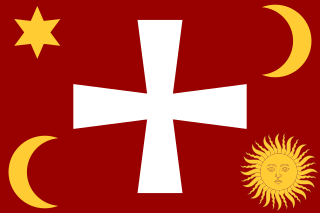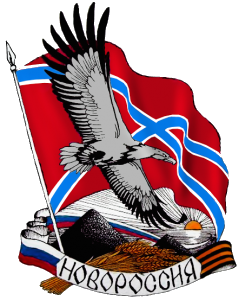
The Pale of Settlement was a western region of the Russian Empire with varying borders that existed from 1791 to 1917 in which permanent residency by Jews was allowed and beyond which Jewish residency, permanent or temporary, was mostly forbidden. Most Jews were still excluded from residency in a number of cities within the Pale as well. A few Jews were allowed to live outside the area, including those with university education, the ennobled, members of the most affluent of the merchant guilds and particular artisans, some military personnel and some services associated with them, including their families, and sometimes their servants. Pale is an archaic term meaning an enclosed area.

Budjak, also known as Budzhak, is a historical region that was part of Bessarabia from 1812 to 1940. Situated along the Black Sea, between the Danube and Dniester rivers, this multi-ethnic region covers an area of 13,188 km2 (5,092 sq mi) and is home to approximately 600,000 people. The majority of the region is now located in Ukraine's Odesa Oblast, while the remaining part is found in the southern districts of Moldova. The region is bordered to the north by the rest of Moldova, to the west and south by Romania, and to the east by the Black Sea and the rest of Ukraine.

The Zaporozhian Sich was a semi-autonomous polity and proto-state of Cossacks that existed between the 16th to 18th centuries, including as an autonomous stratocratic state within the Cossack Hetmanate for over a hundred years, centred around the region now home to the Kakhovka Reservoir and spanning the lower Dnipro river in Ukraine. In different periods the area came under the sovereignty of the Polish–Lithuanian Commonwealth, the Ottoman Empire, the Tsardom of Russia, and the Russian Empire.

Zaporizhzhia or Zaporozhzhia is a historical region in central east Ukraine below the Dnieper River rapids, hence the name, literally "(territory) beyond the rapids".

Nariman Karbalayi Najaf oghlu Narimanov was an Azerbaijani Bolshevik revolutionary, writer, publicist, politician and statesman. For just over one year, beginning in May 1920, Narimanov headed the government of Soviet Azerbaijan. He was subsequently elected chairman of the Union Council of the Transcaucasian SFSR. He was also Party Chairman of the Central Executive Committee of the Soviet Union from 30 December 1922 until the day of his death.

Oleshky, previously known as Tsiurupynsk from 1928 to 2016, is a city in Kherson Raion, Kherson Oblast, southern Ukraine, located on the left bank of the Dnieper River with the town of Solontsi to the south. It is the oldest city of the oblast and one of the oldest in southern Ukraine. It is known for its proximity to the Oleshky Sands, a large desert region. Oleshky is the site of artist Polina Rayko's home, a national cultural monument of Ukraine. It also hosts the administration of Oleshky urban hromada, one of the hromadas of Ukraine. It had a population of 24,124.

The Wild Fields is a historical term used in the Polish–Lithuanian documents of the 16th to 18th centuries to refer to the Pontic steppe in the territory of present-day Eastern and Southern Ukraine and Western Russia, north of the Black Sea and Azov Sea. It was the traditional name for the Black Sea steppes in the 16th and 17th centuries. In a narrow sense, it is the historical name for the demarcated and sparsely populated Black Sea steppes between the middle and lower reaches of the Dniester in the west, the lower reaches of the Don and the Siverskyi Donets in the east, from the left tributary of the Dnipro — Samara, and the upper reaches of the Southern Bug — Syniukha and Ingul in the north, to the Black and Azov Seas and Crimea in the south.

Oleg Anatolyevich Tsaryov is a Ukrainian and Russian businessman, politician and former separatist official in eastern Ukraine.

Novorossiya Governorate was an administrative-territorial unit (guberniya) of the Russian Empire, which existed in 1764–1783 and again in 1796–1802. It was created and governed according to the "Plan for the Colonization of New Russia Governorate" issued by the Russian Senate. It became the first region in Russia where Catherine the Great allowed foreign Jews to settle.

Pryazovia or literally Cis-Azov region is usually used to refer to the geographic area of the north coast of the Sea of Azov, mostly located in south-eastern Ukraine, with a small part in Russia. It is located in the southern part of the Azov-Kuban Lowland within the East European Plain, which surrounds the Sea of Azov for most of the stretch of coastline. In a more general sense it may mean the Azov Sea littoral, and conversely, to be more specific, it may also be referred to as the Northern Priazovye.

Russian separatist forces in Ukraine, primarily the People's Militias of the Donetsk People's Republic (DPR) and the Luhansk People's Republic (LPR), were pro-Russian paramilitaries in the Donbas region of eastern Ukraine. They were under the overall control of the Russian Federation. They were also referred to as Russian proxy forces. They were active during the war in Donbas (2014–2022), the first stage of the Russo-Ukrainian War. They then supported the Russian Armed Forces against the Ukrainian Armed Forces during the 2022 Russian invasion. In September 2022, Russia annexed the DPR and LPR, and began integrating the paramilitaries into its armed forces. They are designated as terrorist groups by the government of Ukraine.

The New Russia Party, or Novorossiya Party, is a political party operating in Ukraine, and in particular regions of Ukraine annexed by Russia The organization was founded by pro-Russian separatists, under the leadership of Pavel Gubarev, on 14 May 2014. The party is formally known as the Social-Political Movement "New Russia Party". It is not registered with the Ministry of Justice of Ukraine.

Novorossiya or New Russia, also referred to as the Union of People's Republics, was a project for a confederation between the self-proclaimed Donetsk People's Republic (DPR) and the Luhansk People's Republic (LPR) in Eastern Ukraine, both of which were under the control of pro-Russian separatists.

Novorossiya is a historical name, used during the era of the Russian Empire for an administrative area that would later become the southern mainland of Ukraine: the region immediately north of the Black Sea and Crimea. The province fell largely within a slightly wider area known in Ukrainian as the Stepovyna and in Russian as the Stepp "Steppe Land", or Nyz "Lower Land". The name Novorossiya, which means New Russia, entered official usage in 1764, after the Russian Empire conquered the Crimean Khanate, and annexed its territories, when Novorossiya Governorate was founded. Official usage of the name ceased after 1917, when the entire area was incorporated in the Ukrainian People's Republic, precursor of the Ukrainian SSR.

Russian irredentism refers to territorial claims made by the Russian Federation to territories that were historically part of the Russian Empire and the Soviet Union, which Russian nationalists refer to as the "Russian world". It seeks to politically incorporate ethnic Russians and Russian speakers living in neighbouring territories outside Russia's modern-day borders. This ideology has been significantly defined by the regime of Vladimir Putin, who has governed the country since 1999.
The National Council of Bessarabia was a separatist organisation was headed by Dmitriy Zatuliveter, of the previously obscure Organization of Transnistrians in Ukraine. It arose in 2014, following the Russian military intervention in Ukraine.

Free Donbas is a public movement and political bloc in the Donetsk Oblast fighting for the separation of the region from Ukraine. The bloc includes several parties and movements. The organization was formed in 2014, in the first six months after the proclamation of independence of the Donetsk People's Republic from Ukraine. Satisfying the requirements of the CEC, this party became one of two admitted to participation in the general elections in the Donetsk People's Republic on November 2, 2014. After registration, the party joined in campaigning in the streets with voters, and also on the Internet. The party supports the independence of the historical and cultural region of Novorossiya from Ukraine.
Velyka Bilozerka is a rural locality (selo) in Vasylivka Raion, Zaporizhzhia Oblast in Ukraine. Before July 18, 2020 it served as the administrative center of Velyka Bilozerka Raion, which was abolished. The population in 2018 was 8339.

Russian imperialism includes the policy and ideology of power exerted by Russia, as well as its antecedent states, over other countries and external territories. This includes the conquests of the Russian Empire, the imperial actions of the Soviet Union, as well as those of the modern Russian Federation. Some postcolonial scholars have noted the lack of attention given to Russian and Soviet imperialism in the discipline.
This is a list article about flags that have been used by pro-Russian separatists in Ukraine and in areas occupied by Russia and Russian-controlled forces during the Russo-Ukrainian War.















